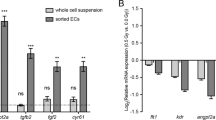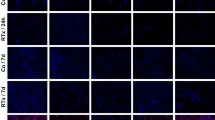Abstract
We have investigated both the effects of X-rays on angiogenesis and the possible role of nitric oxide (NO) on the observed antiangiogenic effect of X-rays, using as an in vivo model the chick embryo chorioallantoic membrane (CAM). These effects were assessed both morphologically and biochemically, by measuring vascular density and collagenous protein biosynthesis, respectively, on days 9 and 14 of the chick embryo development. Vascular density and cytotoxicity of the CAM were also evaluated histologically. We have shown that X-rays have an antiangiogenic effect on the system used and that the NO synthase inhibitor NG-nitro-L-arginine methyl ester (L-NAME) promoted angiogenesis of the non-irradiated CAM and reversed the antiangiogenic effect of irradiation. D-NAME, which is an inactive enantiomer of L-NAME, showed no such effects. L-Arginine, which is the substrate for NO synthase, had a modest antiangiogenic effect on the non-irradiated CAM, no effect on the irradiated CAM and abolished the angiogenic effect of L-NAME on these CAM preparations. These results suggest that NO is involved in the antiangiogenic mechanism of X-rays and that pharmacological manipulation of NO firstly, may offer a better understanding of these mechanisms and, secondly, may also prove to be an alternative therapeutic approach for treating pathological conditions involving angiogenesis.
This is a preview of subscription content, access via your institution
Access options
Subscribe to this journal
Receive 24 print issues and online access
$259.00 per year
only $10.79 per issue
Buy this article
- Purchase on Springer Link
- Instant access to full article PDF
Prices may be subject to local taxes which are calculated during checkout
Similar content being viewed by others
Author information
Authors and Affiliations
Rights and permissions
About this article
Cite this article
Hatjikondi, O., Ravazoula, P., Kardamakis, D. et al. In vivo experimental evidence that the nitric oxide pathway is involved in the X-ray-induced antiangiogenicity. Br J Cancer 74, 1916–1923 (1996). https://doi.org/10.1038/bjc.1996.653
Issue Date:
DOI: https://doi.org/10.1038/bjc.1996.653
This article is cited by
-
The chicken chorioallantoic membrane model in biology, medicine and bioengineering
Angiogenesis (2014)
-
Digital subtraction angiography and computer assisted image analysis for the evaluation of the antiangiogenetic effect of ionizing radiation on tumor angiogenesis
International Urology and Nephrology (2007)
-
Effects of radiotherapy and estramustine on the microvasculature in malignant glioma
British Journal of Cancer (1999)
-
Effects of low dose ionizing radiation on murine chronic granulomatous tissue
Strahlentherapie und Onkologie (1998)



